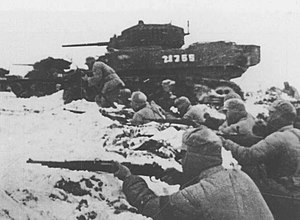| Huaihai campaign | |||||||||
|---|---|---|---|---|---|---|---|---|---|
| Part of the Chinese Civil War | |||||||||
 People's Liberation Army troops, supported by captured M5 Stuart light tanks, attacking the Nationalist lines | |||||||||
| |||||||||
| Belligerents | |||||||||
| Commanders and leaders | |||||||||
| Strength | |||||||||
| 800,000[1] | 1,100,000 combatants - 600,000 regulars, 500,000 reserve militia[2] | ||||||||
| Casualties and losses | |||||||||
| Total: 555,099[citation needed] of which 327,000 were either captured or went over to the Communists. | Total: 134,000[citation needed] | ||||||||

The Huaihai campaign (Chinese: 淮海戰役; pinyin: Huáihǎi Zhànyì), or Battle of Hsupeng (traditional Chinese: 徐蚌會戰; simplified Chinese: 徐蚌会战; pinyin: Xúbèng Huìzhàn), was one of the military conflicts in the late stage of the Chinese Civil War between the Kuomintang and the Chinese Communist Party (CCP). The campaign started when the People's Liberation Army (PLA) launched a major offensive against the Kuomintang headquarters in Xuzhou on 6 November 1948, and ended on 10 January 1949 when the PLA reached the north of the Yangtze.
- ^ Chien, Jimmy (2015). Analyzing Two Key Points of the Huaihai Campaign Using Sun Tzu's Net Assessment (MA). University of Massachusetts Amhers. Retrieved 22 April 2022.
- ^ Chien, Jimmy (2015). Analyzing Two Key Points of the Huaihai Campaign Using Sun Tzu's Net Assessment (MA). University of Massachusetts Amhers. Retrieved 22 April 2022.